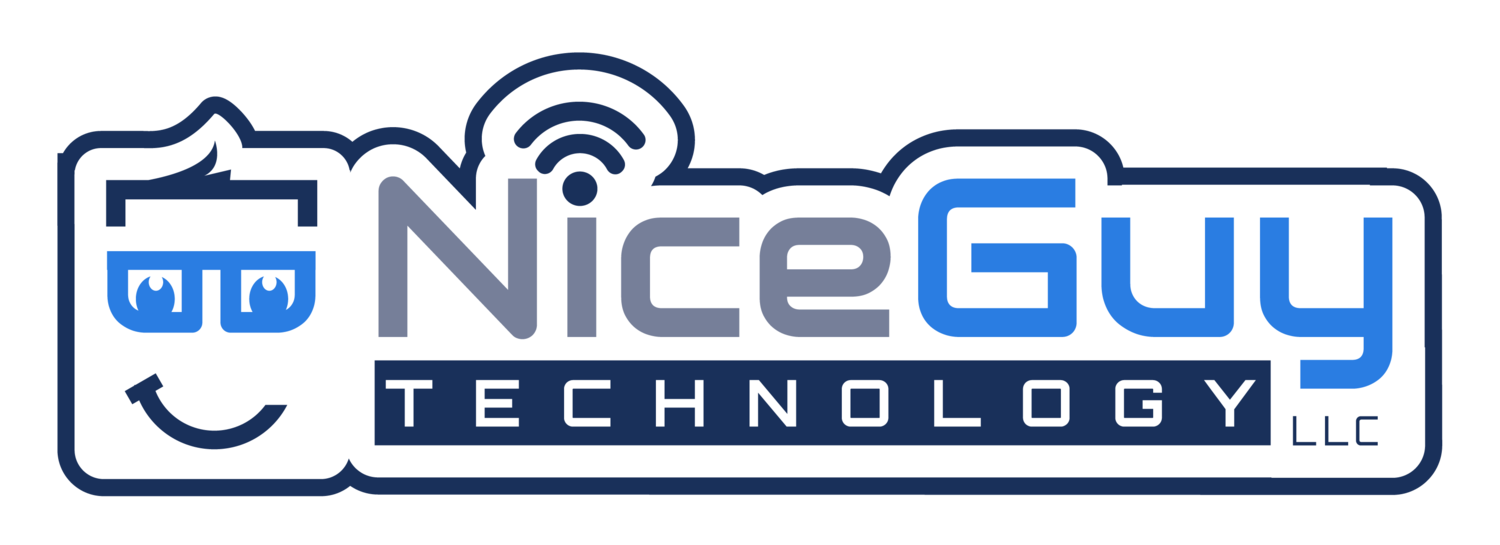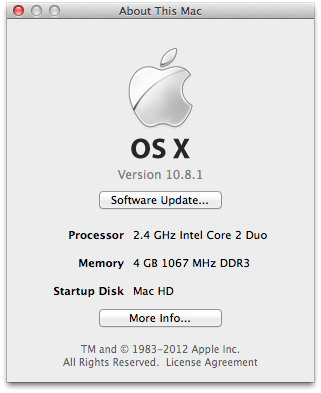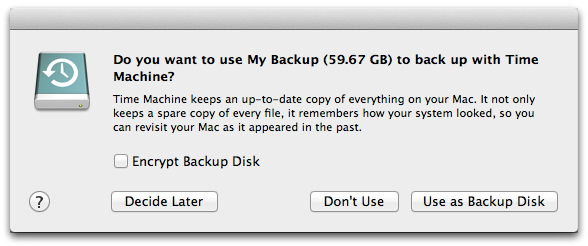Thanks for taking the Getting Started With Your Mac Class. I hope you find this outline helpful to you as a reference to the material we covered. I have included videos and links to various things I think you may find helpful. If you have any further questions don't hestiate to contact Mike.
OS X
This is the operating systems that runs your Mac. On a PC there is Windows and on a Mac there is OS X.
- 2002 - Cheetah (10.2)
- 2003 - Panther (10.3)
- 2005 - Tiger (10.4)
- 2007 - Leopard (10.5)
- 2009 - Snow Leopard (10.6)
- 2011 - Lion (10.7)
- 2012 - Mountain Lion (10.8)
I encourage people to stay up to date with the operating system that runs their computers for a few reasons:
- Better security
- Newer softer often requires technology found in the new operating system
- New features
To determine the version of your Mac click on the little Apple button in the upper left corner of your screen and click on About This Mac.
Not all Macs can upgrade to the newest version of OS X. If you have an older version of OS X and are not sure which version you can upgrade to you can contact Mike.
If you have Snow Leopard (10.6) or Lion (10.7) and you would like to upgrade to Mountain Lion (10.8) there are instructions on how to do so on Apple's website.
Finder
Finder allows you to visually access practically everything on your Mac, including applications, hard disks, files, folders, and CDs. You can use the Finder to organize all your files and folders as you want, search for stuff anywhere on your Mac, delete things you don't want, and more.
It's similar to the Start button in Windows
You can learn more about the Finder by visiting Apple's website.
Desktop
That big expanse of space that takes up the majority of your screen real estate is called the desktop. This is where you do most of your work; applications, files, and folders get opened on the desktop. If you insert a CD or DVD into your Mac, its icon shows up on the desktop. When you connect an external hard drive or flash drive, it shows up on the desktop. You can also store folders and files on it too.
Dock
A virtual shelf to put your most used apps.
You can learn more about the Dock by visiting Apple's website.
Dashboard
These are little widgets that you can install on your computer to check on the weather, get sports scores, track flights, convert currency, etc.
You can learn more about Dashboard by visiting Apple's website.
Launchpad
An app launcher inspired by the iPhone and iPad. This is a convenient location to see all the apps that are installed on your Mac. Only works on Lion (10.7) and Mountain Lion (10.8).
Software Update
On Cheetah (10.2), Panther (10.3), Tiger (10.4), Leopard (10.5), Snow Leopard (10.6), and Lion (10.7) you would use Software Update to download updates to your Mac. With Mountain Lion (10.8) all software updates are now handled through the App Store.
Reasons to update your software:
- Increased security
- Better performance
- Bug fixes
- New Features
You can learn more about updating your software by visiting Apple's website.
App Store
Starting with Snow Leopard (10.6) Apple has started offering software through the App Store.
In 2012, this is the only place to purchase operating system upgrades as well as all Apple software like Pages, Keynote, Numbers, Aperture, etc.
Benefits of purchasing software through App Store:
- Can’t lose discs
- Multiple Macs
- Easy updates
- Comfort of home
Beach Ball of Death
Most Common Causes:
- Not enough RAM
- Hard drive issues
- Corrupt file
When you see the Beach Ball of Death you can Force Quit the application that is not responding.
Command + Option + Esc or Menu > Force Quit
System Preferences
This is where you can customize the settings of your Mac.
- Desktop/Screensavers
- Energy Settings
- Keyboard
- Mouse
- Printers
- and much more!
Spotlight
It's like Google search for your Mac.
You can search for:
- Applications
- Calendars
- Contacts
- Documents
- Music
- Photos
You can also:
- Do calculations
- Get definitions
- Search Google
- Search Wikipedia
You can learn more about Spotlight by visiting Apple's website.
I also wrote a blog post about Spotlight in January 2012.
Time Machine
A survery of 2000 people in 2011 found that less than 40 percent of respondents back up their computers at least once a week. And, almost a third of all respondents back up their computers once per year or never.
Time Machine is a super easy to use piece of software that is on every Mac since Leopard (10.5) came out in 2007. I wrote a [blog post about Time Machine in the Spring of 2012.]
All you have to do is purchase an external hard drive from a local store like Target, Walmart, or BestBuy and plug it into your Mac. If you like to purchase stuff online the hard drive shown below has had good reviews and can be purchased from Amazon.
The following box will pop up:
You click on Use as Backup Disk and the Mac will do all the work for you.
Everytime the external drive is plugged in Time Machine will check to see if there is anything new to backup and will do so if it finds anything.
You can learn more about Time Machine by visiting Apple's website.
Learn How To Get More Out of Your Mac On On Mike's Blog
You can find numerous tips and tricks for the Mac on Mike's blog.
Sign Up For Mike's Blog Posts
You will receive approxmiately three emails a week containing the following:
- Tips on how to use technology (iPads, Macs, Facebook, Google)
- Interviews with people on the apps they use
- Public Service Announcements when there is a threat in the world of technology
- Mike's thoughts on various tech topics
At any point you can unsubscribe if you no longer wish to receive the emails. Approximately 216 people currently receive Mike's blog posts via email.



